*Małgorzata Kołodziejczak1, Przemysław Ciesielski1, 2, Maja Gorajska-Sieńko2, Magdalena Szczotko2
Fistulotomy followed by anal sphincter reconstruction – indications, benefits and pitfalls of the method
Fistulotomia z następową rekonstrukcją mięśni zwieraczy – wskazania, korzyści i pułapki metody
1Warsaw Proctology Centre, Saint Elizabeth’s Hospital in Warsaw
2Department of General Surgery, Hospital of Our Lady of Perpetual Help, Wołomin
Streszczenie
Przetoka odbytu jest chorobą od wieków przysparzającą chirurgom problemów ze względu na wysoki odsetek komplikacji pooperacyjnych w postaci nawrotów choroby oraz objawów pooperacyjnej inkontynencji gazów i stolca. Niniejszy artykuł dotyczy metody operacyjnej wycięcia przetoki z następową rekonstrukcją mięśni zwieraczy.
Nie jest to metoda nowa, jednak w ostatnich latach zyskała na popularności. Wskazaniami do jej zastosowania są przede wszystkim skomplikowane wysokie przetoki odbytu, tylne przetoki przezzwieraczowe u pacjentów z wyjściowo dobrą kontynencją oraz przetoki o „granicznej” wysokości, obejmujące około 50% masy mięśnia zwieracza zewnętrznego. Jeśli przetoka jest wysoka i/lub skomplikowana, zazwyczaj w pierwszym etapie autorzy stosują drenaż luźnym setonem w celu ograniczenia infekcji. Istotna jest ocena kontynencji u pacjenta przed zabiegiem.
W artykule przedstawiono sposób wykonania operacji, możliwe powikłania, dokonano także przeglądu piśmiennictwa dotyczącego doświadczeń innych autorów z tą metodą. Fistulotomia z następową rekonstrukcją mięśni zwieraczy jest operacją odważną, wymagającą dużego doświadczenia w wykonywaniu zabiegów proktologicznych i dedykowaną wyselekcjonowanej grupie pacjentów. Ze względu na możliwe powikłanie w postaci gorszego trzymania gazów i stolca po zabiegu, pacjent powinien być o tym poinformowany przed operacją i podpisać stosowną zgodę na zabieg. W grupie pacjentów z wysokimi, nawrotowymi przetokami odbytu, nieskutecznie leczonych innymi metodami, jest to dobra opcja terapeutyczna.
Summary
Fistula-in-ano is a disease which has challenged surgeons for centuries because of high postoperative complication rates including recurrences, and symptoms of postoperative gas and stool incontinence. The paper addresses the surgical method of fistula excision followed by sphincter reconstruction.
The procedure is not new, but it has gained popularity in recent years. The primary indications for its use include complex high anal fistulas, posterior transsphincteric fistulas in patients with good baseline continence, and fistulas of “borderline” height, involving approximately 50% of the external sphincter mass. In cases of high and/or complex fistulas, the first stage of management is typically loose seton drainage to reduce the risk of infection. Prior to surgical intervention, it is important to assess the patient’s preoperative continence status.
The paper presents the surgical technique of the intervention, outlines possible complications, and reviews the literature reporting the experiences of other authors who use the method. Fistulotomy followed by sphincter reconstruction is a bold surgical approach. It requires extensive experience in performing colorectal surgical procedures, and it is suitable for a selected group of patients. On account of possible complications including impaired postoperative gas and stool continence, the patient should receive appropriate information before surgery, and sign the surgical consent form. Fistulotomy followed by sphincter reconstruction is a good therapeutic option in patients with recurrent high anal fistulas unsuccessfully treated by other methods.

Introduction
Fistula-in-ano is a disease which has challenged surgeons for centuries because of high postoperative complication rates including recurrences, and symptoms of gas and stool incontinence. The multitude of operative methods used today best shows the complexity associated with the treatment of the disease. New methods, the so-called sphincter-sparing techniques (SST), such as laser obliteration, the use of paste, plugs, and tissue adhesives, are not associated with a high risk of postoperative incontinence, but in turn have a high recurrence rate of up to 60% (1). One of the reports evaluating a group of 46 patients with transsphincteric fistulas treated with tissue adhesive shows only 63% efficacy (2). The laser method, on the other hand, is dedicated to patients with fistulas having precisely defined anatomical features (non-branching, with a straight course, an internal opening and a diameter of < 6 mm (3). Moreover, these methods are not reimbursed in Poland by the National Health Fund (NFZ). The above considerations leave out a group of patients with complicated and recurrent fistulas, unsuccessfully treated with other methods. This paper addresses the surgical method of anal fistulotomy followed by sphincter reconstruction. It can be described as a “bold” surgical intervention, requiring extensive experience in performing colorectal surgical procedures. The method is not new: the first publication describing this treatment modality was published in 1985 (4). In the cited report, Parkash et al. outline the application of fistula excision with sphincter reconstruction in the treatment of complex anal fistulas, pointing to the benefits of the method including accelerated wound healing and prevention of anal canal deformity after surgery. Similar reports on the application of the method in the management of complex anal fistulas continued to be published in subsequent years (5).
Indications
The technique has a wide range of indications, but most authors recommend it for the treatment of high/complex anal fistulas. In one of the recent reports, the authors recommend it in the management of high anterior fistulas in women and high transsphincteric fistulas (6).
The authors of this paper use the method in the treatment of transsphincteric fistulas, mostly of the posterior type, in patients with good continence at baseline, fistulas of “borderline” height, involving approximately 50% of the external sphincter mass (lower fistulas should preferably be treated radically by simple fistulotomy; the management of higher fistulas requires a more careful approach with sphincter-sparing methods such as two-stage surgery with a seton, closure of the internal opening or ligation of the intersphincteric fistula tract (LIFT), and selected high suprasphincteric fistulas in patients with very good baseline continence (3).
Also, the method is used for the surgical management of difficult recurrent fistulas when other methods prove ineffective.
Preparation for the procedure
On the day prior to surgery, a clear liquid diet is recommended (water, water with honey, tea, clear juices, broth), and two enemas should be given, for example at 6 pm and 8 pm. The patient requires prophylactic antibiotic coverage because an infection might result in the dehiscence of muscle sutures resulting in postoperative incontinence.
Description of the method
In cases involving high and/or complex anal fistulas, the first step in patient management is drainage with a loose seton to reduce the risk of infection. The duration of drainage depends on the resolution of inflammation, but it is suggested that a seton be left in situ for a period of 8 to 12 weeks before further treatment. In patients with simple low transsphincteric fistulas, the first stage of treatment is bypassed.
In the second stage, after the infection in the adjacent tissues has completely resolved, the drain is removed, and fistulotomy is performed over the probe, followed by curettage, cleaning the bottom of the wound and suturing the cut sphincter. Absorbable monofilament sutures are used. Different suturing methods may be applied, but the authors typically use U-sutures. A key aspect in muscle suturing is that sutures should be placed in perfect symmetry. The anoderm is sutured carefully over the sutured muscle. The wound is left open for healing around the periphery to ensure good drainage and prevent infections. After suturing the muscles, it is important to evaluate anal tightness, which is an indirect indicator of good continence after surgery (fig. 1-4).
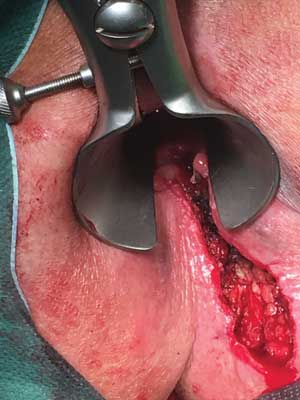
Fig. 1. Incision of fistula tract
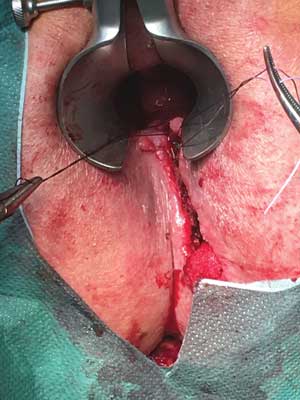
Fig. 2a. Suturing of muscles
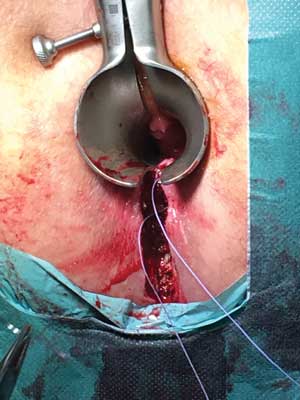
Fig. 2b. Suturing of muscles
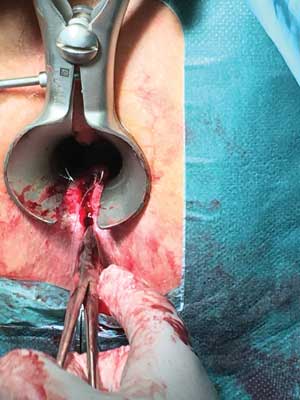
Fig. 3. Suturing of anoderm
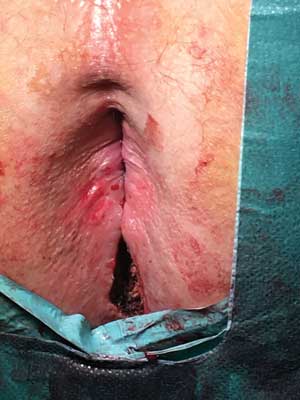
Fig. 4. Post-surgical wound
If the desired effect is not achieved, it may be necessary “let go of the sutures” and perform the reconstruction again.
Several modifications of the method have been described. One of them involves the application of special double sutures bringing the muscles closer together, referred to as Lasheen’s sutures after the author of the publication (7).
Possible complications
The most serious complication is the dehiscence of sutured muscles leading to postoperative incontinence. Another risk is fistula recurrence.
Literature review and discussion
Powyżej zamieściliśmy fragment artykułu, do którego możesz uzyskać pełny dostęp.
Mam kod dostępu
- Aby uzyskać płatny dostęp do pełnej treści powyższego artykułu albo wszystkich artykułów (w zależności od wybranej opcji), należy wprowadzić kod.
- Wprowadzając kod, akceptują Państwo treść Regulaminu oraz potwierdzają zapoznanie się z nim.
- Aby kupić kod proszę skorzystać z jednej z poniższych opcji.
Opcja #1
29 zł
Wybieram
- dostęp do tego artykułu
- dostęp na 7 dni
uzyskany kod musi być wprowadzony na stronie artykułu, do którego został wykupiony
Opcja #2
69 zł
Wybieram
- dostęp do tego i pozostałych ponad 7000 artykułów
- dostęp na 30 dni
- najpopularniejsza opcja
Opcja #3
129 zł
Wybieram
- dostęp do tego i pozostałych ponad 7000 artykułów
- dostęp na 90 dni
- oszczędzasz 78 zł
Piśmiennictwo
1. Ratto C, Litta F, Donisi L, Parello A: Fistulotomy or fistulectomy and primary sphincteroplasty for anal fistula (FIPS): a systematic review. Tech Coloproctol 2015; 19(7): 391-400.
2. Maralcan G, Başkonuş I, Gökalp A et al.: Long-term results in the treatment of fistula-in-ano with fibrin glue: a prospective study. J Korean Surg Soc 2011; 81(3): 169-175.
3. Kołodziejczak M, Ciesielski P, Kamiński F: Atlas technik operacyjnych w proktologii. Wydawnictwo Borgis, Warszawa 2019: 62-66, 111-115.
4. Parkash S, Lakshmiratan V, Gajendran V: Fistula-in-ano: treatment by fistulectomy, primary closure and reconstitution. Aust N Z J Surg 1985; 55(1): 23-27.
5. Gemsenjäger E: Erfahrungen mit einem neuen Therapiekonzept bei Analfistel: Naht des analen Sphinkters. Schweiz Med Wochenschr 1996; 126(47): 2021-2025.
6. Anaraki F, Etemad O, Abdi E et al.: Assessment of fistulectomy combined with sphincteroplasty in the treatment of complicated anal fistula. J Coloproctol (Rio J) 2017; 37(3): 232-237.
7. Lasheen AE, Safwat K, Sieda B et al.: Fistulectomy and primary repair of wound and anal sphincter by Lasheen’s sutures for high perianal fistula. Edorium J Surg 2015; 2: 16-20.
8. Roig JV, Garcia?Armengol J, Jordán JC, Solana: Immediate reconstruction of the anal sphincter after fistulectomy in the management of complex anal fistulas. Colorectal Dis 1999; 1(3): 137-140.
9. Roig JV, García-Armengol J, Jordán JC et al.: Fistulectomy and sphincteric reconstruction for complex cryptoglandular fistulas. Colorectal Dis 2010; 12(7 Online): 145-152.
10. Litta F, Parello A, De Simone V et al.: Fistulotomy and primary sphincteroplasty for anal fistula: long-term data on continence and patient satisfaction. Tech Coloproctol 2019; 23(10): 993-1001.
11. Ratto C, Litta F, Parello A et al.: Fistulotomy with end-to-end primary sphincteroplasty for anal fistula: results from a prospective study. Dis Colon Rectum 2013; 56(2): 226-233.
12. Perez F, Arroyo A, Serrano P et al.: Fistulotomy with primary sphincter reconstruction in the management of complex fistula-in-ano: prospective study of clinical and manometric results. J Am Coll Surg 2005; 200(6): 897-903.
13. Jayarajah U, Wickramasinghe DP, Samarasekera DN: Anal incontinence and quality of life following operative treatment of simple cryptoglandular fistula-in-ano: a prospective study. BMC Res Notes 2017; 10(1): 572.
14. Arroyo A, Pèrez-Legaz J, Moya P et al.: Fistulotomy and sphincter reconstruction in the treatment of complex fistula-in-ano: long-term clinical and manometric results. Ann Surg 2012; 255(5): 935-939.
15. Perez F, Arroyo A, Serrano P et al.: Randomized clinical and manometric study of advancement flap versus fistulotomy with sphincter reconstruction in the management of complex fistula-in-ano. Am J Surg 2006; 192(1): 34-40.
16. Perez F, Arroyo A, Serrano P et al.: Prospective clinical and manometric study of fistulotomy with primary sphincter reconstruction in the management of recurrent complex fistula-in-ano. Int J Colorectal Dis 2006; 21(6): 522-526.
17. De Hous N, Van den Broeck T, de Gheldere C: Fistulectomy and primary sphincteroplasty (FIPS) to prevent keyhole deformity in simple anal fistula: a single-center retrospective cohort study. Acta Chir Belg 2020; 1-6.
18. Farag AFA, Elbarmelgi MY, Mostafa M, Mashhour AN: One stage fistulectomy for high anal fistula with reconstruction of anal sphincter without fecal diversion. Asian J Surg 2019; 42(8): 792-796.
19. Ommer A, Herold A, Berg E et al.: German S3 guidelines: anal abscess and fistula (second revised version). Langenbecks Arch Surg 2017; 402(2): 191-201.





